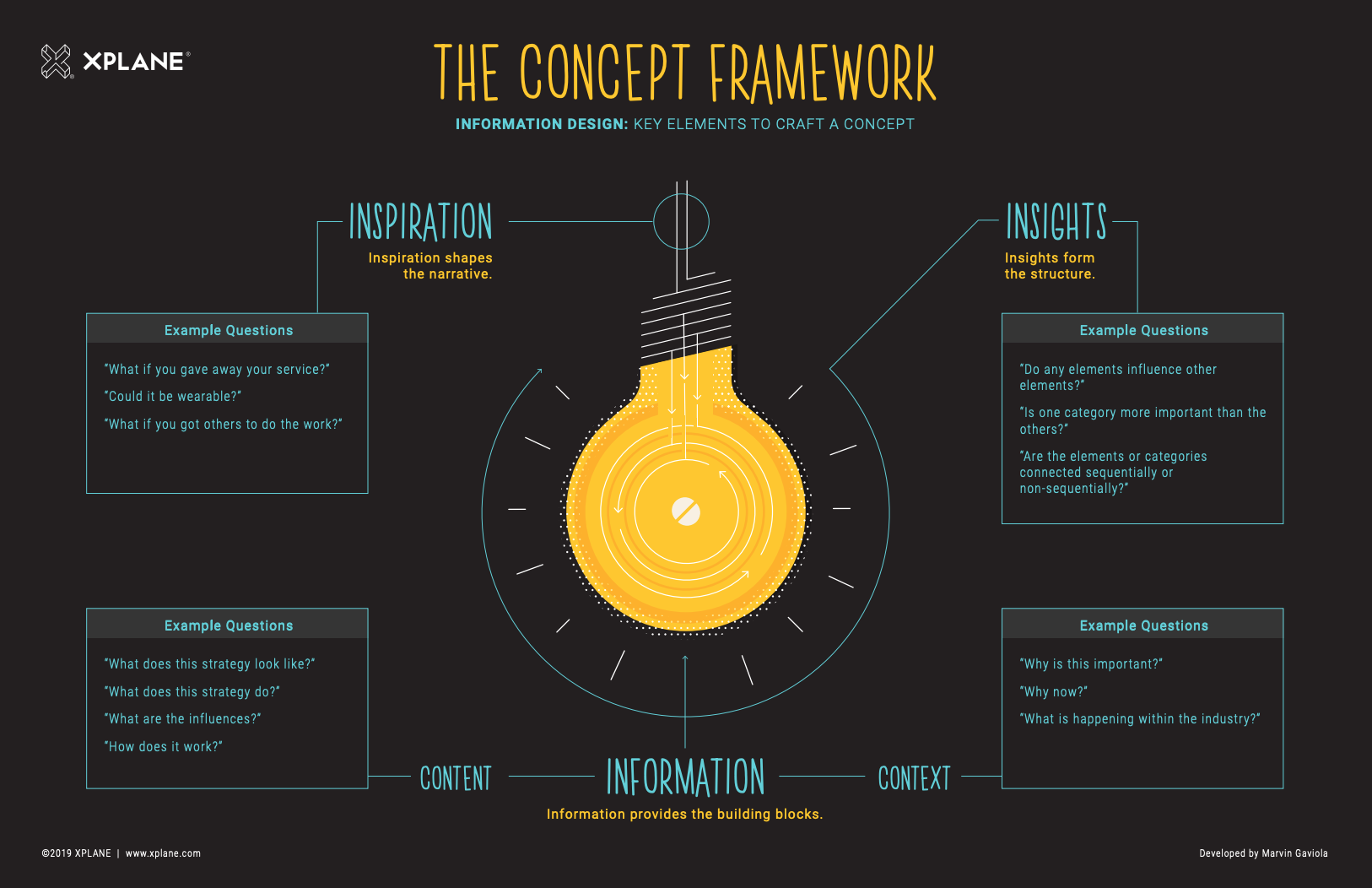If you’re a designer tasked with creating a visual map of your company’s strategy, assessing whether you have all the information you need to visualize the concept is critical.
As an information designer, I’ve developed visual solutions that tackle business strategy, vision, process, and systems over the past 12+ years. The visual usually takes the form of a single infographic, albeit a fairly robust and, sometimes, dense visual. At times, the content might also take the form of a narrative (a presentation or animation) or an interactive experience.
Regardless of the form, designers need to know what elements are necessary to craft a visual that informs and resonates.
Unpacking the Right Information
Content is King
A Discovery workshop—an interactive workshop that gets you discussing, thinking, brainstorming, and prototyping through drawings and activities—can be as short as two hours or as long as several days, weeks, or even months.
“What” and “how” questions are the primary vehicles for structuring conversations during Discovery:
- “What does this strategy look like?”
- “What does this strategy do?”
- “What are the influences?”
- “How does it work?”
Methodically navigating these questions and more stirs up a lot of content.
XPLANE works “out loud” on the walls, meaning that decisions, discussions, activities, milestones, and any relevant content is put on a sticky note and placed on the walls or sketched on a whiteboard.
If it’s not on the walls, it’s information that will not be included in the solution. In this regard, content is king—it is the information needed to develop strategy.
Context is Crucial
“What” and “how” are only part of the information you’ll need to design an effective visual.
You’ll also need to know “why.”
- “Why is this important?”
- “Why now?”
- “What is happening within the industry?”
In any design process, understanding the audience’s perspective, business objectives, and project requirements is fundamental to the success of a visual solution. Context is crucial to pinpoint important content and provide direction to develop the strategy.
Unpacking the right content with the right context gives you building blocks to develop strategy.
The Value of Insight
Information generated during Discovery can be overwhelming and difficult to shape into a coherent visual because it’s inherently unwieldy and messy.
For a message to resonate, information needs structure and direction. Sense-making activities, such as affinity mapping (creating categories of information), help mold mountains of data into chunks of information that begin to make sense.
While Discovery workshops primarily focus on unpacking information, they also uncover insights that shape, mold, and give information direction and structure.
As an information designer, I look at data differently than my consultant partner. I want to know what elements I’m working with. I don’t want to just know the individual data points—I need to know what the categories of data mean.
More to the point, I need to understand the relationships between categories of data.
“Do any elements influence other elements?”
“Is one category more important than the others?”
“Are the elements or categories connected sequentially or non-sequentially?”
The value of insight is how it provides direction and structure. Insights form unconnected data into a structure or sequence that starts to tell a story.
Although context also provides structure, the structure and direction context provides typically relates to what data is more important. Insight, on the other hand, helps craft the narrative to tell a story from a specific point of view and shows relationships between data.
For instance, discussions may identify a barrier that can hinder successful adoption of the strategy. The insight of changing the strategy to cope with the barrier could change the fundamental structure of the strategy.
The Creative Force of Inspiration
Visioning, brainstorming, and other activities that produce possible solutions spur a variety of ideas. Even if these ideas are preliminary or do not connect entirely to the information, they are useful tools that can inspire a different perspective and, perhaps, a novel approach.
In this regard, inspiration during Discovery may inform the final solution. Different perspectives introduce iterations that can yield surprising outcomes. Questions that are unexpected or provocative push the solution for the better. Here are some prompts I’ve used:
- “What if you gave away your service?”
- “Could it be wearable?”
- “What if you got others to do the work?”
Ideation and inspiration should, of course, continue on through the concept and design phase. It is, however, useful to get different perspectives during the workshop. The creative force of inspiration should not be overlooked; it can fundamentally shape the narrative.
The Process of Creativity
Completing a Discovery workshop brings a sense of relief and accomplishment. The Discovery team has carried out a solid plan, negotiating conversations, capturing information and insights, and making sense throughout.
When you’re tasked with creating an effective information design concept, take things one step at a time. You have information (content and context), insight, and inspiration all awaiting the process of creativity.
The Concept Framework
We’ve created a simple framework to remind information designers about the key elements needed to craft a successful visual.

